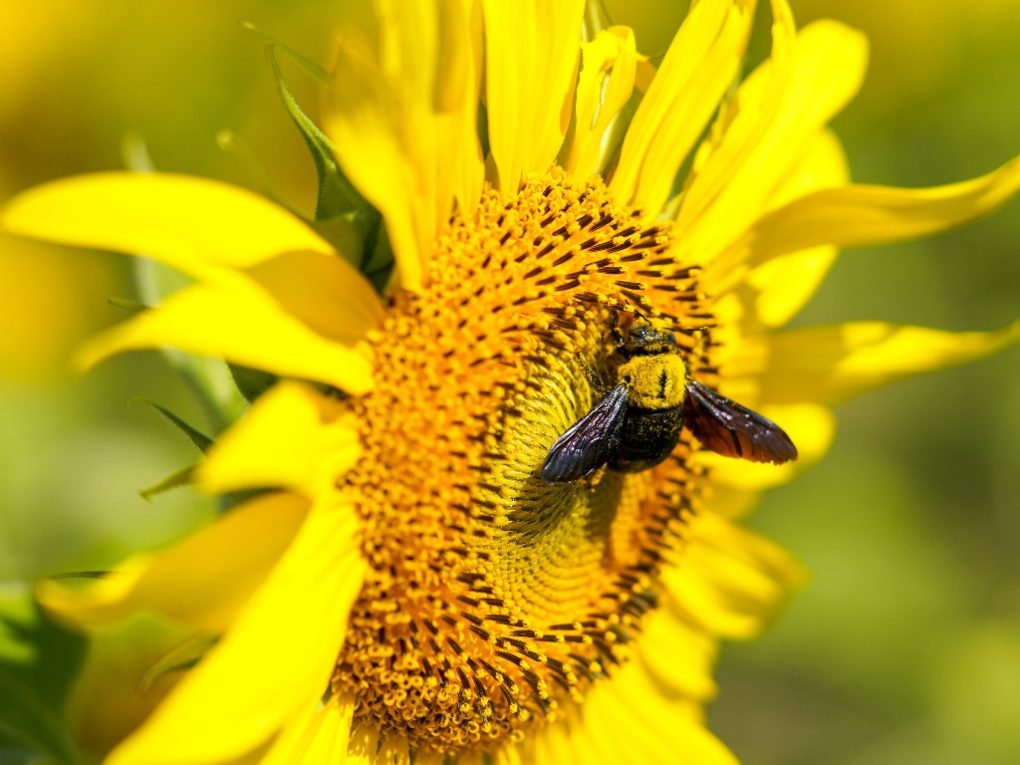Why Do Sunflowers Face the Sun: Understanding the Importance of Heliotropism for Sunflowers
Sunflowers exhibit heliotropism, or the ability to turn their heads and face the sun as it moves across the sky, to attract more pollinators like bees. By facing the sun, sunflowers can capture more sunlight which is important as bees are attracted to warm flowers.

Heliotropism occurs because of a special growth hormone called auxin, which causes the stem to grow more on one side than the other. During the early stages of growth, sunflower plants will face east in the morning and then follow the sun as it moves across the sky, ending up facing west at sunset. The process is reversed overnight, and the plants will face east again in the morning.
Table of Contents
The Benefits Sunflowers Get From Facing the Sun
Increased Photosynthesis
Following the sun helps in photosynthesis in sunflowers by maximizing the amount of sunlight the plant receives. Heliotropism allows the sunflower to orient its leaves and flowers towards the sun, ensuring they receive the maximum sunlight.
Photosynthesis is the process by which plants use sunlight, carbon dioxide, and water to produce energy in the form of glucose. Sunflowers rely on photosynthesis to grow and develop, and the more sunlight they can capture, the more efficiently they can produce energy.
When a sunflower follows the sun, it allows its leaves to be perpendicular to its rays. This means the sunlight directly hits the leaves and is absorbed more efficiently. The leaves also align themselves to reduce the shade they create on other parts of the plant, which maximizes the amount of sunlight that can be absorbed.
In addition to optimizing the amount of sunlight absorbed, following the sun can also help regulate the plant’s temperature. By facing the sun, the plant can absorb more heat, which can help to warm the plant’s tissues and promote photosynthesis. On the other hand, the plant can reduce its exposure to heat by facing away from the sun.
Enhanced Water Absorption
Following the sun helps in water absorption in sunflowers by increasing the rate of transpiration, which is the process by which plants lose water through their leaves. As mentioned, when a sunflower follows the sun, it positions its leaves perpendicular to its rays, exposing them to more sunlight and heat.
The increased heat causes the water in the leaves to evaporate more quickly, which creates a lower pressure gradient that draws water up from the roots and into the stems and leaves of the plant. This process is called transpiration and is driven by the plant’s need to transport water and nutrients throughout its tissues.
By following the sun, sunflowers can increase the transpiration rate and promote more efficient water absorption. This is important because water is essential for photosynthesis and plant growth, and sunflowers require large amounts of water to produce their large flowers and seeds.

Additionally, sunflowers can reduce the shade they create on other parts of the plant by following the sun. Shade can cause leaves to retain moisture, increasing the risk of fungal or bacterial growth. In addition, sunflowers can promote better air circulation and reduce disease risk by minimizing shade.
Better Pollination
Following the sun does not directly help with pollination in sunflowers, but it can indirectly attract pollinators by increasing the visibility and accessibility of the flowers. Sunflowers have large, showy flowers arranged in a distinctive pattern called a “head”.
The head contains hundreds of individual flowers arranged in a spiral pattern, with the outer flowers being larger and more visible than the inner ones. Each flower contains male and female reproductive organs and must be pollinated to produce seeds.
By following the sun, sunflowers can position their heads in a way that maximizes their exposure to sunlight and increases the visibility of their flowers. This can make it easier for pollinators like bees, butterflies, and hummingbirds to locate and access the flowers, increasing the likelihood of successful pollination.
Additionally, sunflowers produce nectar and pollen, which can serve as a food source for pollinators. By producing large quantities of nectar and pollen and positioning their flowers in a way that is visible and accessible to pollinators, sunflowers can attract a wide variety of pollinators and increase the chances of successful pollination.
Improved Seed Production
Facing the sun can improve seed production by allowing the plant to maximize its exposure to sunlight, which is essential for photosynthesis. Sunflowers can absorb more sunlight by facing the sun, increasing the energy available for seed production.
Also, facing the sun can help regulate temperature and moisture levels within the plant. Sunflowers are sensitive to changes in temperature and moisture, and exposure to too much heat or too little water can negatively affect seed production. In addition, sunflowers can regulate their internal temperature and moisture levels by facing the sun, promoting healthy growth and development.
In addition, acing the sun can help to attract pollinators, which are essential for successful seed production in sunflowers. As mentioned, sunflowers produce large, showy flowers arranged in a distinctive pattern. By positioning their flowers in a way that is visible and accessible to pollinators, sunflowers can increase the likelihood of successful pollination and seed production.

What Happens When a Sunflower Cannot Face the Sun
As discussed, heliotropism is an adaptation that helps sunflowers maximize their exposure to sunlight, which is essential for photosynthesis, growth, and reproduction. If sunflowers cannot face the sun, their growth and development can be harmed.
If sunflowers cannot face the sun due to shading or other factors, they may become stunted or produce fewer flowers and seeds. This is because they will not be able to absorb as much sunlight as they need to fuel photosynthesis and growth. Sunflowers that cannot face the sun may also become more vulnerable to pests and diseases, as their growth and development will be weakened.
However, it is worth noting that not all sunflowers follow the sun to the same extent. For example, some sunflowers, such as dwarf varieties or those with very large flowers, may exhibit less heliotropism than others.
Additionally, sunflowers can adjust their growth and development to some extent in response to environmental changes. For example, if other plants shade them, they may grow taller or produce more branches to reach more sunlight.
